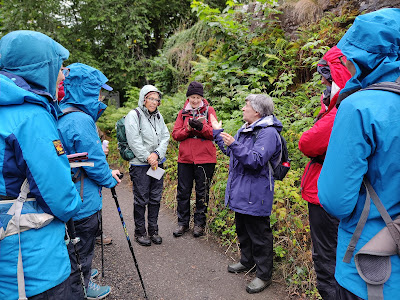I had helped to organise a field trip for Inverness Botany Group, which was a walk up "The Big Glen" in Golspie to look at ferns with an expert (Dr Heather McHaffie). The weather forecast was pretty grim so we were all dressed up in waterproofs, but apart from the odd shower, it was much better than expected.
 |
| Heather explaining about ferns to some well wrapped up botanists! |
Those round brown spots on the underside are called sori and hold little packets of spores. The colour and shape are key features when you are trying to identify ferns, as different species have different shaped sori. I found out that there are three different polypodies, which look much the same, but have different spores (this is starting to sound like lichens!). I took a little bit home and put it under the microscope.
 |
| Close up of sori on polypody |
The orange blobs are made up of lots of little spheres, which - if you look closely - have a wormlike strip along one side, and are full of tiny bean shaped sporesHere's one of the spores, much enlarged:
So what is the purpose of the wormlike strip? When conditions are right, it pings open the sphere into 2 halves and the spores are flung out. AS you will see my video skills are minimal but if you have the patience,watch the 27 second video and keep your eyes on the bottom right to see a "ball" opening and then flinging the spores out . It reminded me of a trebouchet (one of those siege engines that lob boulders at castles!)
On the way home we passed a sandbank with basking harbour seals.
 |
 |
| Embo beach |
 |
 |
| Large Bindweed on left, Hedge Bindweed (at Embo) on the right |
Large Bindweed can get very large - here's some climbing up the trees near Clune Terrace Play Park in Newtonmore.
In Newtonmore, you can also find Bindweed growing in the Jack Richmond Memorial Park and by Loch Imrich.
What, a whole post and no lichens? Maybe in the next post!














